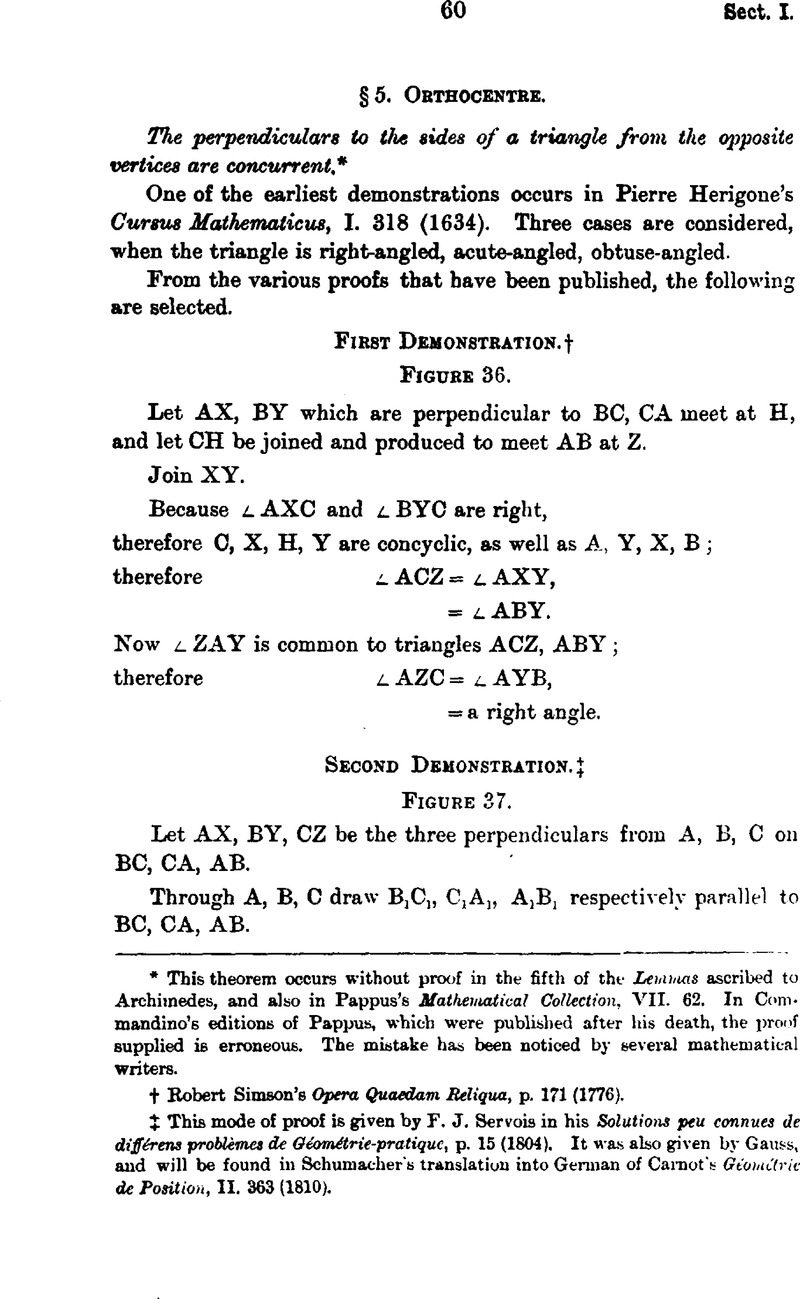No CrossRef data available.
Article contents
Abstract

- Type
- Other
- Information
- Copyright
- Copyright © Edinburgh Mathematical Society 1883
References
* This theorem occurs without proof in the fifth of the Lemmas ascribed to Archimedes, and also in Pappus, 's Mathematical Collection, VII. 62. In Commandino's editions of Pappus, which were published after his death, the proof supplied is erroneous. The mistake has been noticed by several mathematical writers.Google Scholar
† Simson, Robert's Opera Quaedam Beliqua, p. 171 (1776).Google Scholar
‡ This mode of proof is given by Servois, F.J. in his Solution peu connues de diftrens problèmes de Géomttrie-pratiquc, p. 15 (1804)Google Scholar. It was also given by Gauss, and will be found in Schumacher's translation into German of Carnot, 's Geometric de Position, II. 363 (1810).Google Scholar
* MrBernh, . Möllmann in Grunert's Archiv, XVII., 376 (1851).Google Scholar
† Booth, James's New Geometrical Methods, II. 260–1 (1877).Google Scholar
‡ Gergonne, 's Annaies, XIX. 37–64 (1828)Google Scholar, or Steiner, 's Gesammette Werke, I. 193 (1881).Google Scholar
* This useful expression was suggested by Dr Ferrers and Dr W. H. Besant in 1866–7. It is introduced in DrBesant's, Conic Sections, § 138 (1869).Google Scholar
† MrVigaré, Emile in Mathesis, VII. 61 (1887).Google Scholar
‡ DrBooth, James in his New Geometrical Methods, II. 261 (1877).Google Scholar
§ Carnot, , Corrélation des Figures de Géométrie, §143 (1801).Google Scholar
* Carnot, 's Gémétric dc Position, §151 (1803)Google Scholar. The term antiparallel was first used by Antoine Arnauld. See Noureaux Éléments dc Géométric, par Messrs de Port-Royal, p. 212, or livre onzième (1667). Further information regarding the use of the word will be found in two letters from MrLangley, E.M. to Nature, XL., 460–1 (1889), and XLI., 104–5 (1889).CrossRefGoogle Scholar
* These are taken from an article by MrBrocard, H. in the Nouvelle Correspondance Mathématique, VI. 145–151 (1880).Google Scholar
* Feuerbach, , Eigenschaften…des…Dreiecks, §24 (1822).Google Scholar
* Lucas, Édouard in Nouvelle Correspondance Mathématique, II. 95, 218 (1876).Google Scholar
* Carnot, élation des Figures de Géométrie, § 146 (1801)Google Scholar, or Gé;ométric de Position, § 130 (1803).Google Scholar
* Nouvelles Annales, 2nd series, XIX. 176 (1880) and 3rd series, I. 186–9 (1882).Google Scholar
* This corollary is established in the proof of the theorem known as Brahmegupta's.
* DrTaylor, C. in Mathematical Questions from the Educational Times, XVIII. 65 (1872).Google Scholar
† This property and the demonstration of it are due to Professor R. E. Allardice.
* MrMiller, W.J.C. in the Lady's and Gentleman's Diary for 1802, p. 74.Google Scholar
* “Conic ”of St John's College, Cambridge, in the Lady's and Gentleman's Diary for 1863, p. 51.Google Scholar
† Jacobi, C.F.A., Dc Triangulorum Rectilineorum Proprietatitus, p. 34 (1825).Google Scholar
* Tuschis, J.F.de a Fagnano in Nova Acta Eruditorurn anni 1775, p. 296.Google Scholar
† See ProfAllardice, R.E.'s paper “ On a property of odd and even polygons” in the Proceedings of the Edinburgh Mathematical Society, VIII. 23 (1890).Google Scholar
‡ Marsano, , Considerazioni sul Triangolo Rettilinco, pp. 18, 19 (1863).Google Scholar
* Lhuilier, , Élmens d'Analyse, p. 231 (1809)Google Scholar. The proof in the text is given by Feuerbach, , Eigenschaften…des…Dreiccks, Section VI., Theorem 8 (1822).Google Scholar
* This theorem is due to Mr Rochat of Saint-Brieux, and is thus stated in Gergonne, 's Annales de Mathématiques II. 93 (1811–2).Google Scholar
If to any triangle T there be circumscribed another T′ and to T′ a third T″ having its sides respectively parallel to those of T; then to T″ a new triantjle T′″ having its sides respectively parallel to those of T′, and so on: the triangles T, T″, T′″ will be similar inpairt and form, a geometrical progression.
The demonstration in the text is given by MrAnne, Leon, in the Nouvelles Annales, III. 27 (1844).Google Scholar
* The theorem (46)–(48) are given by Feuerbach, , Eigenschaften…des…Dreiecks, §§ 61, 8, 63 (1822).Google Scholar
* The first parts of (56) and (57) are given by Feuerbach, , Eigenschaften…des…Dreiecks, §§ 87, 88 (1822).Google Scholar
* Feuerbach, §89.
† Feuerbach, §80. The mode of proof is not his.
* Feuerbaeh (§90) proves the congruency of XYZ, H1H2H3
* G′ would naturally denote the centroid of triangle A′B′C′, but G is the centroid both of ABC and A′B′C′.
* See ProfessorDöttl, Johann's Neue merkuürdiye Punkte des Dreiecks pp. 40–46 (no date). The proofs given in this noteworthy pamphlet are analytical.Google Scholar
* The notation here is somewhat complicated, but it could not well be otherwise. I have made various attempts to simplify it, but with little tuccess; what is gained in one respect is lost in another.
* This method of proof is due to Professor Neuberg.
Of the last seventeen properties,(84), (85), (91) are given by Levy, W.H. of Shalboume in the Lady's and Gentleman's Diary for 1837, pp. 50–1, in his answer to a question proposed by him the previous year.Google Scholar
At the Concours d'agrégation des sciences mathématiques (Paris, 1873)Google Scholar the following question was proposed:
The points of contact of the excirclcs of a triangle ABC which are situated on the sides produced are joined, and a new triangle A′B′C′ is formed. (1) Find the angles of A′B′C′. (2) Prove that AA′, CC′ arc the altitudes of ABC. (3) Determine tlte centre and the radius of the circumcircle of A′B′C′.
In the Nourelle Correspondance Mathématique, I. 50–3 (1874)Google Scholar, Professor Neuberg gives a geometrical solution of the question, in which (confining himself to triangle X1, Y2, Z3) he proves (85), (80), (87), (91), (92), (93), (94) and one or two other properties. ProfessorNeuberg, in the 6th edition of Casey's Sequel to Euclid;, p. 278 (1892) and Professor Fuhrmann in his Syntactsche Beta isc plxniiutlriflu r Sätze, p. 89 (1890), give the first part of (97).Google Scholar
The seventeen properties were communicated to the Edinburgh Mathematical Society in 1889.




